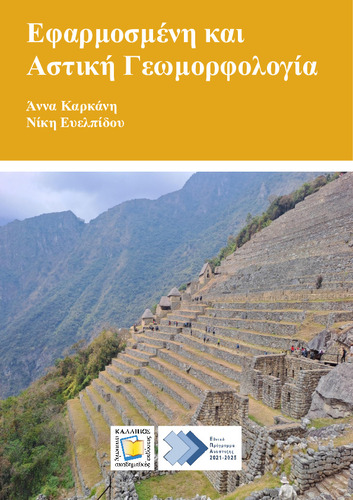| Title Details: | |
|
Applied and Urban Geomorphology |
|
| Authors: |
Karkani, Anna Evelpidou, Niki |
| Reviewer: |
Maroukian, Habik |
| Subject: | NATURAL SCIENCES AND AGRICULTURAL SCIENCES > EARTH SCIENCES > GENERAL GEOLOGY > GEOMORPHOLOGY NATURAL SCIENCES AND AGRICULTURAL SCIENCES > EARTH SCIENCES > GENERAL GEOLOGY > GEOGRAPHIC INFORMATION SYSTEMS NATURAL SCIENCES AND AGRICULTURAL SCIENCES > EARTH SCIENCES > GENERAL GEOLOGY > GEOENVIRONMENT NATURAL SCIENCES AND AGRICULTURAL SCIENCES > AGRICULTURAL SCIENCES > NATURAL RESOURCES, EARTH AND ENVIRONMENTAL SCIENCES > NATURAL RESOURCES |
| Keywords: |
Geomorphology
Urbanization Urban environment Natural hazards Human-induced hazards Geomorphological hazards Erosion Coastal erosion Floods Tsunamis Environmental tourism |
| Description: | |
| Abstract: |
Before humans left their first footprints in Africa, the Earth's surface was shaped solely by the natural geophysical processes of climate, tectonic uplift, volcanism and erosion, sediment transport and deposition. While these processes continue to shape the relief, human societies have increasingly acquired the ability to act as a new force of geomorphological change, adding to and interacting with pre-existing natural forces in shaping the relief through activities such as fires, the ploughing of land for agriculture, the construction of settlements, dams, mines, roads, and other infrastructure. Therefore, a full assessment and understanding of the formation and evolution of today's landforms requires an understanding of the anthropogenic processes that have contributed to their formation. Applied Geomorphology focuses on geomorphological environments and the processes that involve societies. It includes the application of geomorphology to answer research questions of geomorphological importance to society and to find solutions to a variety of social-environmental problems affected by landforms and geomorphological processes. In other words, Applied Geomorphology can be defined as geomorphology at the service of society and man. In this context, this book focuses mainly on applications of Geomorphology and on changes in the geomorphological environment due to human interventions, as well as on natural geomorphic processes that affect man. It aims to understand the changes brought about by anthropogenic activities in the geomorphological environment and to manage and assess risks such as floods and erosion. The book analyses the main methods and techniques used in geomorphology, anthropogenic interventions and the alteration of the relief, the effects of urbanisation, and the assessment of geomorphological risks, such as erosion, floods and landslides. The interaction of man with the environment, and the effects of anthropogenic interventions on geomorphological phenomena and vice versa, are described. In addition, case studies from the Greek area are presented and analysed. Overall, this book aims to contribute to a better understanding of the contribution of the human factor to the transformation of natural relief, the environmental impacts and the geomorphological hazards that can lead to a multitude of environmental changes with human implications.
|
| Linguistic Editors: |
Tzouxanioti, Maria |
| Graphic Editors: |
Tzouxanioti, Maria |
| Type: |
Undergraduate textbook |
| Creation Date: | 09-10-2023 |
| Item Details: | |
| ISBN |
978-618-228-116-1 |
| License: |
Attribution - NonCommercial - ShareAlike 4.0 International (CC BY-NC-SA 4.0) |
| DOI | http://dx.doi.org/10.57713/kallipos-350 |
| Handle | http://hdl.handle.net/11419/10830 |
| Bibliographic Reference: | Karkani, A., & Evelpidou, N. (2023). Applied and Urban Geomorphology [Undergraduate textbook]. Kallipos, Open Academic Editions. https://dx.doi.org/10.57713/kallipos-350 |
| Language: |
Greek |
| Consists of: |
1. Introduction to Applied and Urban Geomorphology 2. Methods and techniques in Geomorphology 3. Urban Geomorphology: landforms and processes in cities 4. Runoff erosion 5. Floods and flood hazard 6. Geomorphological interactions in the coastal zone: natural and anthropogenic factors 7. Coastal hazards 8. Geomorphology and environmental tourism 9. Case studies |
| Number of pages |
246 |
| Publication Origin: |
Kallipos, Open Academic Editions |
| You can also view | |
| User comments | |
There are no published comments available! | |

